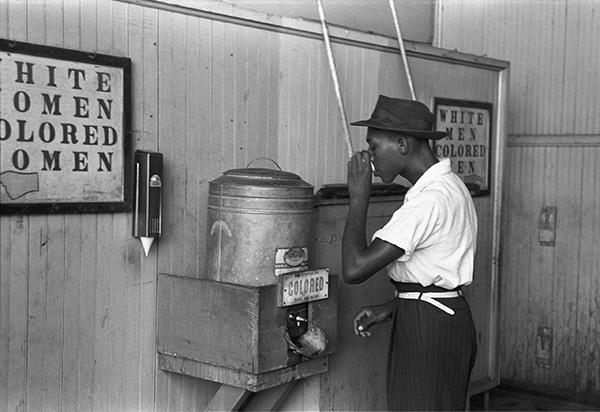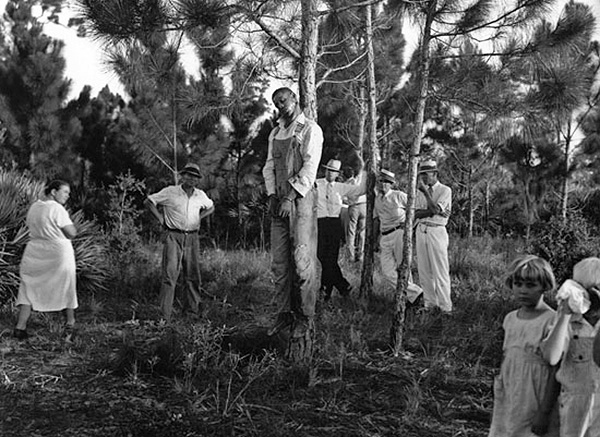Bob Avakian has written that one of three things that has “to happen in order for there to be real and lasting change for the better: People have to fully confront the actual history of this country and its role in the world up to today, and the terrible consequences of this.” (See “3 Things that have to happen in order for there to be real and lasting change for the better.”)
In that light, and in that spirit, “American Crime” is a regular feature of revcom.us. Each installment focuses on one of the 100 worst crimes committed by the U.S. rulers—out of countless bloody crimes they have carried out against people around the world, from the founding of the U.S. to the present day.
See all the articles in this series.


August 14, 2017. A Confederate statue is pulled down in Durham, NC. Credit: twitter/@DerrickQLewis
THE CRIME:
Today there are over 1,500 monuments, statues, buildings, roads, schools, parks, and military bases across the U.S. honoring the leaders, generals, and soldiers of the Confederate states that waged the Civil War (1861-65) to defend slavery.
The biggest wave of Confederate monument construction took place from 1890 to 1920, after Reconstruction was ended. Hundreds of monuments and statues were built, at least 189 of them on courthouse grounds, and almost all of them in the South. A smaller construction spike took place from the mid-1950s to the late 1960s, when over 45 were dedicated or rededicated nationally.
Soon the Southern landscape was dotted with Confederate memorials, especially of military leaders dressed in full uniform, often mounted on horseback. The main Confederate generals Robert E. Lee, “Stonewall” Jackson, and Nathan Bedford Forrest; as well as the Confederate president Jefferson Davis and vice president Alexander Stephens, were favorites.
What did these men stand for? After the South seceded, Alexander H. Stephens declared: “Our new government’s foundations are laid, its cornerstone rests, upon the great truth that the Negro is not equal to the white man, that slavery—subordination to the superior race—is his natural and normal condition.”
Nathan Bedford Forrest was a slave trader and the first national grand wizard of the KKK. He led his troops to massacre hundreds of Black Union soldiers who had surrendered—at both Fort Pillow and Brice’s Cross Roads.
Robert E. Lee wrote: “The blacks are immeasurably better off here than in Africa, morally, socially & physically. The painful discipline they are undergoing is necessary for their instruction as a race.”
“Stonewall” Jackson believed, according to a Virginia Tech scholar, that “the Creator had sanctioned slavery, and man had no moral right to challenge its existence....”
Jefferson Davis: “We recognize the negro as God and God’s Book and God’s Laws, in nature, tell us to recognize him. Our inferior, fitted expressly for servitude.”
Many of the monuments carried flowery inscriptions memorializing Confederate soldiers and their cause. One in Anderson, North Carolina, was inscribed, “[T]he soldiers who wore the grey, and died with Lee, were in the right.” Another declared the monument was “erected in memory of confederate soldiers, and the sacred cause for which they contended....”
A dedication ceremony held in 1901 in Monroe County, West Virginia, was attended by over 10,000 people including prominent officials and businessmen. Many were decked out in “Confederate grey... [and the] speakers’ stand adorned with bunting and Confederate flags.” Speakers praised Robert E. Lee as “the grandest man of all ages.”
Confederate monuments and statues were put up in parks, cemeteries, schools, roads, military bases, on government lands and buildings. Today there are more than 700 (some estimate there are over 1,000) in 31 states and the District of Columbia. Most are in the South, especially Virginia (96), Georgia (90), and North Carolina (90). But there are also monuments across the country, from Arizona and California to New York, from Washington State to Washington, DC, where there are 13 statues of Confederates in the U.S. Capitol Building.
Besides monuments, there are 10 major U.S. military bases named for Confederate military leaders; nine official Confederate holidays in six Southern states; at least 109 public schools named after prominent Confederates. There are also highways and roads, streets and parks named for Confederates.
The second, smaller, wave of monument building took place in the 1950s and 60s, during the civil rights and Black liberation struggles. One was the gigantic (400 feet tall) Confederate monument at Stone Mountain in Georgia State Park. It has three huge sculptures of Robert E. Lee, Stonewall Jackson, and Jefferson Davis on horseback, carved in granite on a mountainside within 20 miles of Atlanta. Four million tourists visit each year. It was conceived in 1912 but completed in 1972, and since 1915, Stone Mountain has been a rallying site for Ku Klux Klan (KKK) cross burnings and recruitment rituals.
THE CRIMINALS:
In 1894, a group of Southern women formed the United Daughters of the Confederacy. For over a century, they’ve played a central role in erecting, celebrating, and defending Confederate monuments. The UDC also began spreading the poisonous mythology of the “Lost Cause of the Confederacy” that romanticizes slavery and justifies the Confederacy and white supremacy through an array of cultural and educational means such as books and films.
After Reconstruction was ended in 1877, the ruling classes of the South as well as the then-dominant North supported these monuments as a means of unifying the country on the foundation of maintaining white supremacy and the oppression of Black people after slavery had been abolished.
For instance, in 1912, President William Howard Taft, speaking to the United Daughters of the Confederacy convention, upheld the honor of the Confederate cause: “No son of the South and no son of the North, with any spark in him of pride of race, can fail to rejoice in that common heritage of courage and glorious sacrifice that we have in the story of the Civil War and on both sides of that Civil War.”
President Woodrow Wilson was a member of the Sons of Confederate Veterans, whose official logo/emblem is the Confederate flag. In 1914, he led a dedication ceremony for the Arlington National Cemetery Confederate Memorial.
To this day, powerful forces in the ruling class, now concentrated in the fascist Trump/Pence regime, uphold these Confederate monuments and all they represent. On August 22, 2017, after the white supremacist assaults in Charlottesville, Virginia, Trump declared, “And yes by the way... they are trying to take away our history and our heritage. You see that.” Vice President Pence stated, “I can’t help but think that instead of tearing down monuments, as some are want to do, rather than tearing down monuments that have graced our cities for years, we ought to be building more monuments.”
THE ALIBI:
During the first wave of Confederate monument building, their supporters felt no need to hide their real intent. A speaker at the 1913 North Carolina University dedication to Confederate soldiers said it was “their courage and steadfastness [that] saved the very life of the Anglo Saxon race in the South.”
Today the UDC and other Confederate monument defenders claim the monuments are reminders of U.S. history and removing them would be “erasing” that history, and that these concrete markers exist for “heritage not hate.” They portray the Civil War as being fought over “states’ rights,” not slavery. On its website, the UDC describes their purpose as “honoring the memory of its Confederate ancestors; protecting, preserving and marking the places made historic by Confederate valor; collecting and preserving the material for a truthful history of the War Between the States; recording the participation of Southern women in their patient endurance of hardship and patriotic devotion during and after the War Between the States....”


“Colored” drinking fountain in streetcar terminal, Oklahoma City, Oklahoma. Source: Library of Congress
THE ACTUAL MOTIVE:
In reality, these monuments were built to uphold Southern slavery and white supremacy as part of imposing Jim Crow segregation, a new form of brutal white supremacy and oppression of Black people.
Black people were once again chained to the land—often former plantations—under the sharecropping system in relations barely better than slavery.
Laws were passed legalizing segregation and robbing Black people of basic rights. Between 1890 and 1908, Southern states adopted new constitutions and passed laws disenfranchising Black people. Racial discrimination and segregation were upheld by the U.S. Supreme Court. By 1914, every Southern and many Northern cities had enacted Jim Crow laws discriminating against Black people. “Whites only” customs and rules were enforced in hotels, hospitals, bathrooms, restaurants, drinking fountains, cemeteries, schools, workplaces, and on buses and trains. Southern states passed laws preventing Black people from voting through poll taxes, literacy tests, and other measures. Over a dozen states outlawed interracial sex and marriage.
One teacher’s resource website gives a sense of the horrific impact Jim Crow had on millions of Black people, for decades on end: “That declarative phrase—Whites Only—can’t adequately communicate the implicit boundaries and unspoken social codes and customs in place during the Jim Crow era, nor can it suggest exactly how treacherous this world was for black southerners. A single gesture, a movement, an expression, or a question could be perceived as a violation of Jim Crow boundaries. Black men and women who demonstrated too much aspiration, confidence or success became targets of harassment, assault, arson, and murder.”
The lynching of Rubin Stacy in Florida, 1935. Photo: AP
The KKK and white vigilantes were supported and unleashed to enforce all this and terrorize Black people. Between 1877 and 1950, 4,084 Black people were lynched, according to the Equal Justice Initiative.
States outside the South didn’t all impose overt Jim Crow segregation, but the U.S. rulers did enforce white supremacy, segregation, Jim Crow, and the super-exploitation and brutal oppression of Black people in other ways. The construction and preservation of Confederate monuments for over 150 years has been part of the cementing of bourgeois ruling class unity, North and South, with white supremacy a core component of the social, political, and ideological cohesion and stability of U.S. capitalism-imperialism.
Confederate monuments were built to legitimize white supremacy and this lynch mob terror. In 1930, the UDC’s official publication, The Southern Magazine, spelled out the purpose of honoring the Confederacy:
“The next task was to build up a new economic order, one without slavery, but one which recognized the ignorance, lack of skill, vagrant habit, and animal sensuality of the negroes [sic]...these poor ignorant, barbarous children, freed from the wholesome restraint of southern influence, were made the tools of the alien white vandals from the North, and became not only idle, vicious, thieving and insolent, but also a monstrous menace to white womanhood.”
As revcom.us has summed up, “These statues were built to, and still do, strike a chill in the bones and souls of those who suffered under this rule, or who hated it for simple human reasons.”
Sources:
The Oppression of Black People & The Revolutionary Struggle to End All Oppression, by Bob Avakian, www.revcom.us April 25, 2016
The Oppression of Black People, The Crimes of This System and the Revolution We Need, Revolution/revcom.us special issue
Take the Statues Down, by Yoni Applebaum, The Atlantic, August 13, 2017
Lies Across America: What our Historic Sites Get Wrong, by James W. Loewen, The New Press, 1999.
Jim Crow Summary and Analysis, www.shmoop.com
List of monuments and memorials of the Confederate States of America; Lost Cause of the Confederacy, The Battle of Fort Pillow, www.wikipedia.com
I’ve Studied the history of Confederate Memorials. Here’s what to do about them, by Fitzhugh Brundage, August 18, 2017, vox.com
Equal Justice Initiative (EJI.org)

